- Offensive Techniques & Strategies
Rebounding Basics
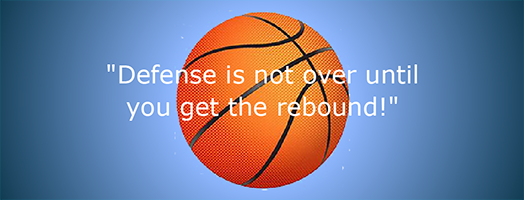
What to Discover or Recall . . .
Find Out that, although defensive and offensive rebounding are two very distinct skills, they to have four things in common: Anticipation, Flight Time, Location, and Determination.
Discover that "Flight Time" is the time it takes for the ball to leave a shooter's hand until it gets into a position that can be rebounded.
Desire and determination allows players with lesser physical abilities to out perform players with greater talent.
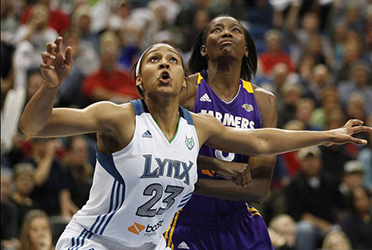
Most coaches have a tendency to look at rebounding in terms of total rebounds, and view rebounding as a single endeavor. In fact, until 1973 rebounds were kept as a single statistic and not broken down into offense and defense. However, offensive and defensive rebounding are entirely two distinct basketball skills and techniques. Defensive rebounding relies mainly on positioning and strength while offensive rebounding requires agility and movement. Defensive rebounding also requires a total team effort while offensive rebounding is mainly an individual effort. Therefore, defensive and offensive rebounding skills and techniques must be addressed and perfected separately.
| Anticipation | Flight Time | Location | Determination | Common Errors |
Although, offensive and defensive rebounding require two very different skills and techniques, they do have four things in common:
Assuming all shots will be missed
"Flight Time" effort
Anticipating rebound location
Determination & Aggressiveness

Assume All Shots Will be Missed
Do not watch the flight of the ball. Over 50% of field goal attempts and 35% of free throws are going to be missed. Therefore, players must anticipate that all shots will be missed. However, it is not a simple matter. Basketball is a game of habits and one of the worst rebounding habits is watching the flight of the ball, especially the last shot of a game. Instead of watching the flight of the ball, much like a great outfielder, players must assume that the shot will be missed and move into proper position for the rebound. To do this players must develop a aptitude and attitude to rebound every shot whenever they are on the court (game, practice, pickup, etc.).

Flight Time
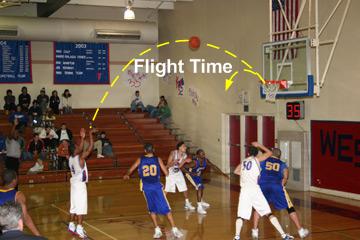
"Flight Time" is the time it takes for the ball to leave a shooter's hand until it gets to a position where it can be rebounded. This normally takes 2 to 3 seconds. What players do, or do not do, during this Dead Time period will determine their success or failure in rebounding. Flight Time is when great players excel. They establish rebounding position prior to the ball hitting the rim.

Rebound Location
Before you can rebound the ball, offensively or defensively, you need to know where to rebound it. Rebound location is dependent on three factors:
-
The angle from the basket
-
The shot distance
-
The shooter's touch
Basically, the majority of the time, the rebound will occur on the side opposite the shooter.
Shot Angle
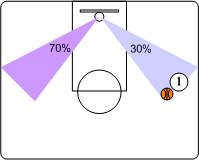
On a shot from the wing the ball will bounce to the opposite side approximately 70% of the time. A minority of shots will bounce directly back toward the shooter or hit the edge of the rim and deflect straight down.

Low angle shots from along the base line because of the backboard have a much narrower range. However, the percentages are about the same as a shot from the wing.
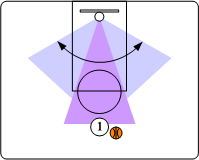
Shots taken from the top of the circle area are much more difficult to read since they involve a much wider range. In addition to being short or long, rebounders must determine if the shot is traveling directly to or is to the left or right of the basket.
Shot Distance
Normally, the longer the shot, the further away from the basket it will bounce. The shooter's touch will also have an impact on the distance of a rebound. impact the distance. A shot with high arc and back spin will hit in paint while line drive type shots will rebound further away from the basket. Be alert for "Air Balls" and be the first to get to them.
Shooter's Touch
Know the shooter's "shooting touch." A shooter with a soft touch and good back spin shot is most likely to rebound close to the basket. Shooters that shoot the ball hard or with little arch will rebound much further way from basket. However, rebounders must also analyze the path of the ball, and determine if the shot is long or short, headed straight toward the rim or is off to the left or right side of the basket. A shot that is short is most likely to rebound directly down or back towards the shooter.

Determination & Aggressiveness
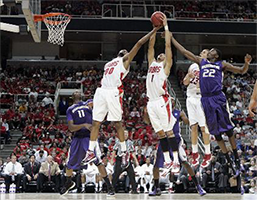
Rebounding in Traffic
Being in the right place at the right time is not enough when it comes to rebounding. To be highly successful, players must want, and be very determined, to get the ball. This mental aspect of rebounding is just as important as the actual physical techniques. Desire and determination is also what allows players with lesser physical abilities to out perform players with greater talent. Want the ball and go get it!

Ten Common Errors Made In Rebounding
Watching the flight of the ball.
Assuming the shot will be made.
Assuming a teammate will rebound the ball.
Relying too much on jumping ability or size and not blocking out on shot
Running under or getting pushed too far under the basket.
Moving into a position directly behind an opponent.
Not wanting the ball and fighting for good inside position.
Not anticipating and going to the spot where the ball will be rebounded.
Rebounding with one hand, and not grabbing or protecting the ball.
Making a bad outlet pass or throwing the ball away after obtaining the rebound.
Learn more Defensive Rebounding Skills & Techniques - Click Here
For Offensive Rebounding Skills & Techniques - Click Here
Return to Player Development - Click Here
Return to Coaching Strategies - Click Here
Return to HoopTactics - Click Here>
© 2026 HoopTactics All Rights Reserved.
